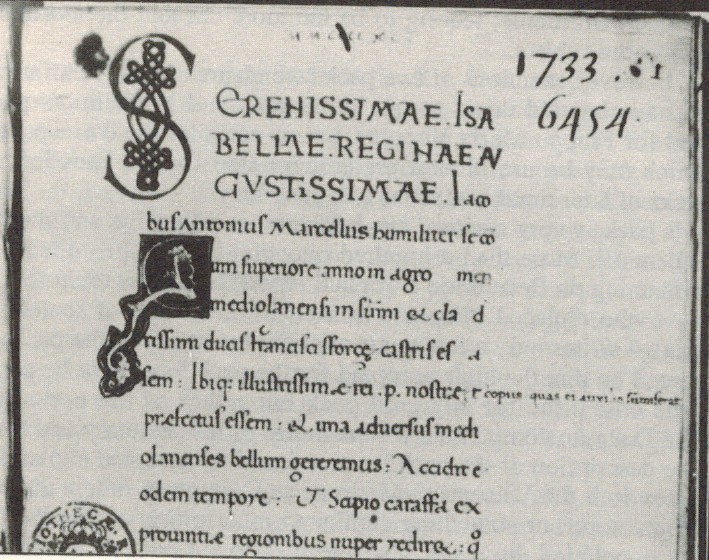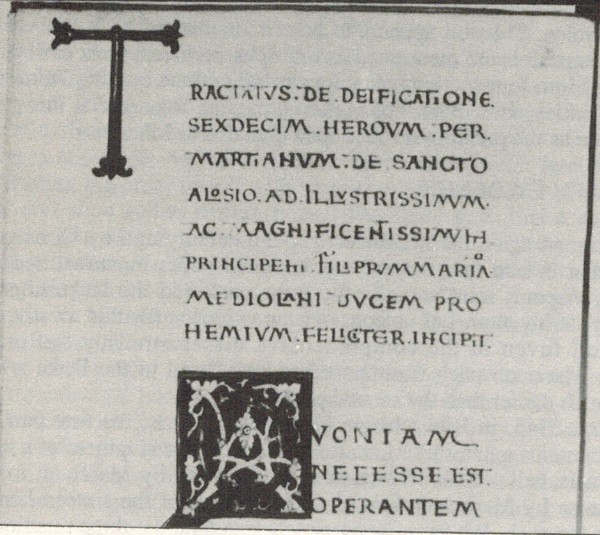PREAMBLE AND ACKNOWLEDGEMENTS
During my recent research about the origin and the early diffusion of tarot, I had opportunities to comment on some findings from Florence, Ferrara, Venice, Bologna, and so on; not yet from Milan. Certainly, the Milanese contribution to the diffusion of tarot cannot be considered late; on the contrary, it represents in any case a milestone in the subject. However, I was reluctant to investigate the connected questions for two main reasons 1) many articles and full books already existed about Visconti-Sforza tarot packs and their possible provenance and authorship; 2) I feared that several towns in the neighborough of Milan should also be taken into account, such as Pavia, Cremona, Mantova, and so on.
Now, it is time for my first contribution to that debated matter, dealing with cards which may bring us near to the very origin of tarot. Before beginning my report, I would like again to acknowledge the advices and encouragements by those who let this whole series be published, Messrs Chicco, Collett, Denning, and especially Miss Sylvia Mann (who also provided the title to these New Discoveries.)
INTRODUCTION
As known, the first diffusion of tarot occurred very rapidly: early mentions occur from Ferrara, Bologna, Milano and several other towns of the Po plain. It is now very difficult to discover among those possible candidate which the actual town of origin was. Certainly, in no case have mentions and particularly cards themselves been kept in so rich a selection as it occurs for Milan. That circumstance is mainly due to the interest in tarot by the Dukes of the Milanese court; it was not only a single personage, but several members of the Visconti and Sforza families, who showed peculiar interest in those cards. Everybody knows the three main Visconti-Sforza packs which have handed down to us and other cards from further packs of same provenance. On one hand historians of cards have contributed to the connected questions; on the other, historians of art have often found the work by Bonifacio Bembo (and by other painters involved in such production) worth investigating. As a matter of fact, however, the historians of art, who have recently studied the question of authorship and date of Visconti packs, did not reach a plausible agreement. In front of the old and also of the new discussions about the authorship and date of the three main Visconti-Sforza packs, any layman is precisely in same situation as if he looked at a three card monte, fearing to be the more cheated the more accurately he follows the subject.
There are, however, mentions of two packs which are certainly earlier than those which have handed down to us: Marziano’s and Michelino’s packs, both prepared for Filippo Maria Visconti. Let us consider the corresponding evidence which may be useful as a preliminary step for the knowledge of Milanese packs of later times and of tarot in general.
Marziano’s pack is very curious, maybe the most expensive and the most unusual of them all. More than a hundred quotations might be collected by authors commenting on Decembrio’s original report. It suffices to remind that Decembrio - who replaced Marziano himself in the charge of secretary to Filippo Maria - writes only a few years after the invention of the pack. It is generally agreed on that the high sum paid for the pack has not to be considered as a true cost price for any card pack but rather as the opportunity seized by the Duke to compensate for the duties of his secretary and former educator. The description of the pack has not found an accepted explanation: some have seen in it the Visconti di Modrone or Cary pack, others the original of Mantegna tarot, or something similar to other preserved packs. Most authors have concluded, however, that the mentioned pack is so different from known ones, that hardly any tarot pack could be meant.
Michelino’s pack is even less known. Durrieu was the first to call attention on it (already in a conference held on March 1895 in Paris,) and to publish some excerpts from a letter of a Venetian leader sending the pack to Queen Isabella of Lorraine. This too appears to be a non-standard pack, since sixteen gods and four birds are mentioned as triumphs, whereas, most curiously, they are divided into four sections. Among several authors quoting Durrieu’s study, Miss Moackley adds in her description a passing remark that this pack may be the same as the previously mentioned one, due to Marziano.
DOCUMENTARY EVIDENCE
If one cares to read again the text investigated a century ago by Durrieu, it finally results that indeed the two above mentioned packs manufactured for Filippo Maria Visconti were actually the same pack and the Duke himself was reportedly its inventor. Let us consider the evidence for this mostly unexpected result (even in the comprehensive dissertation by Sellin on Michelino the Marziano pack is supposed to be offered to the Duke while still a child, much earlier than the second pack.)
In codex Lat. 8745, in Bibliothèque Nationale of Paris, the first part, of interest here, contains a letter by Marcello introducing the shipment of a tarot pack to Queen Isabella; an introduction or "Prohemium" by Marziano to his treatise; a treatise by Marziano about the "deification" of the sixteen heroes represented in the pack. We are now passing to examine the three mentioned parts, obviously dwelling more extensively upon matters of peculiar interest to card history.
1. The letter by Jacopo Antonio Marcello. (Lv. 1r-4r; 7 pp.)
The beginning of the letter reports some facts which had occurred during the previous year. Marcello was then in the camp of Francesco Sforza in the neighbourhood of Milan as leader of the Venetian troops which - together with those of Sforza - were fighting against the Milanese. It occurred that Scipio Caraffa coming back from France brought some news about the Queen and the King of Lorraine, who apparently were very familiar with Marcello himself. During Caraffa’s visit, a pack of cards from the game which is called triumph (ex eo ludo quem triumphum a[p]pellant cartae) was brought to Marcello and given him as a present. As soon as Caraffa sees the cards he urges Marcello to send them at once to the Queen of Lorraine, in order to let her rest from the continuous troubles and afflictions connected with the government. To that aim, according to Caraffa, nothing could be more efficient.
The cards which had appeared so beautiful to Caraffa, however, don’t appear to Marcello worth sending to a Queen since they did not appear well enough pictured and engraved (neque enim pro regio fastigio ornatae et excultae esse videbantur). Something better ought to be found. Thus, Marcello begins to look for some craftsman who is expert of these productions (solertissimus harum rerum artifex.) [A confirmation for us that some painters were already specialised in the making of triumphs and renowned as such.]
While thinking and caring about it, Marcello becomes acquainted that Filippo Maria Visconti, Duke of Milan, had invented a certain new and fine kind of triumphs (novum quoddam et exquisitum triumphorum genus), as usual for him since he was accustomed to such inventions in several fields.
Marcello shortly describes the pack. There were sixteen celestial barons and princes (sexdecim coeli principes ac barones), to them four kings were added heading the order of different birds (his adiungebantur quatuor reges diversarum avium generi praesidentes.) The Duke gave this scheme of the whole game to a scholar [certainly to be identified with Marziano da Tortona] very expert of astronomy (syderum ac coeli peritissimo) in order to compile and describe the game. Not even yet satisfied the Duke charged moreover famous painter Michelino da Besozzo to picture the whole game in the most original and decorative way.
Having known that, Marcello concludes that his previous research of an artist for picturing a pack for the Queen has to be abandoned; this pack [by Filippo-Marziano-Michelino] is THE pack to look for. Day and night he only thinks how, after the death of the Duke, he can obtain the cards. There were obvious difficulties in order to find out a single book and those cards themselves among the great disorder into which the rich furnishing and goods of the Duke possessions had fallen. [Although not explicitly stated, we can suppose the book was by Marziano and the pack by Michelino; leaving unanswered the question whether Marziano had earlier pictured a pack too, or he had only pictured the book, or else he had only arranged and described the personages for the cards, without picturing anything.] The more difficult was the task, as only from enemies could information be gained. Marcello has thus occasion to convince himself that nothing is impossible to somebody wishing to honour his lord and prince. In fact, with also a certain help by fortune, he obtains both cards and book. The satisfaction is so big that no words can describe it; he leaves it entirely to the Queen to imagine.
Marcello gives book and cards to Giovanni Cossa in order to bring them to the Queen and also adds those superior cards (adiunxi et(?) eis cartas illas superiores,) although they are not of suitable level for the Queen. In fact the nobility, brightness of dignity, force, pride of government of the Queen are so high that they can make valuable any insignificant thing. After some further commendations and memories, in the closure of the letter Marcello asks the Queen to remind him to her husband the king of Lorraine, while resting and playing the game using this new Italian invention (hoc novo Italico invento.)
The letter is dated from Monselice, Ides of November, 1449. As known, Monselice is a little town near Padua, and Ides occur by the middle of the month, corresponding to the 13th November if the classical use was followed.
2. Proem of Martianus treatise. (Lv. 4v-6v; 5 pp.)
[The treatise by Martianus is divided into two parts: i) an introduction which shortly justifies the subject and gives some indication about the composition of the pack, ii) a description of the selected gods. Practically in every case some typical biographical facts are summarised and an indication is given of their usual way to be portrayed. Thus, even if we don’t have the original pack, we at least get from these descriptions an idea of its appearance.]
The treatise is titled "Tractatus de Deificatione Sexdecim Heroum" by Martianus from Sant’Aloisio. [The provenance of Marziano is usually mentioned as Tortona, a big town of about 40 thousand inhabitants at the time. However, it is known that he really was from Sant’Alosio, a little village near Tortona, reported as provided with two high and slender towers and a medieval architectonic structure. Most of our information about Marziano’s biography derives from a conference by Aristide Arzano, published in 1904, also containing the transcription of a speech in his praise, delivered soon after Marziano’s death by renowned Professor Barziza.] The sixteen gods are not intended as born as such; instead they are generally considered to have been popular heroes, deified after their death.
The work is devoted to Filippo Maria, Duke of Milan [thus after the stay in Pavia during the leadership of his brother Giovanni Maria. Although it is yet impossible to give an exact date to the treatise, it should come from the 1414-1418 years, in any case earlier than any other information we have yet on the subject.]
The game has been compiled in a fourfold order; there are inserted such great personages in order to induce strength and courage besides diversion and to stimulate the Duke, while he plays, better to follow the virtues.
There are four orders of gods:

[A comment may at once be deserved to the four "suits". At first sight, they seem to be quite original; however, if the usual interpretations of the four suits in a standard pack are considered, the originality of these orders is strongly reduced: it is not difficult to suspect denari under riches, spade under virtues, coppe under pleasures, even if the association of bastoni with virginity or even with temperance, the alternative name of the order, is to me something still unheard of.]
Below these cards there are four birds so chosen as to be in analogy with the suits’ meaning:

each of them subject to its own king (una quaeque proprio parens regi.) [Certainly, to hear of a king in a pack of cards may not be considered out of place! Nevertheless, a common pack is not easy to recognise when only kings are mentioned as courts and only four birds are mentioned as the rest of the pack! However, the following statement provides a confirmation - not fully explicit indeed - to the presence of a full pack of pips.] The order of the birds is such that no kind has any power over a different one (Harum vero Avium ordo est quia nulla earum species in alteram vis habet.) The power (i.e., usual taking power in playing) is direct for eagles and turtles, reverted for phoenices and doves (Aquilarum et turturarum multae paucis praesunt, ...foenicum una et columbarum pluribus pauciores imperant.) There is also an explanation of literary style: in case the objects are to follow the highest the best, in case they are to escape, the lowest the best. [This is the first time we hear something alike, from a chronological point of view, but such statements are well known to historians of cards from different old sources in Europe and India. Also the suits correspond, if interpreted as above.] However, each of the gods will be higher than all orders of the birds and than kings of the orders (Deorum vero quisque omnibus ordinibus avium et ordinum regibus praeerit.)
The gods among themselves have to respect this law: who first is noted lower down will be higher than all the following ones. (Sed inter se dii hac lege tenebuntur, quod(?) qui prior inferius annotabitur sequentibus omnibus praesit.) [Here I am not certain of the meaning; probably, the first god to be played has to be considered as the highest card.] Then it is noted that there are several gods of same name, as three Jupiter - two being Arcadians, the third from Crete - four Apollo, three Diana and equally for the following ones (et quia constat multos eiusdem nominis fuisse deos quemadmodum Joves tres, duos Archades, tertium cretensem, Apollines quatuor, Dianas tres et reliquorum itidem.) Nevertheless, only one has to be considered in the deification, otherwise the game assumed for pleasure will bore the players for a too big complexity. And Marziano passes to the following main part of the treatise, containing the single descriptions for each of the sixteen personages.
3. Martianus treatise. (Lv. 7r-31v; 50 pp.)
It may be of some interest to consider the order of the personages, since Martianus explicitly states the ordinal number of most of the gods in his selection:

On the whole, we have the same table as above with in this case the "suits" being listed following the columns instead of the rows. The gods happen to follow an order which continuously scans different "suits". Perhaps, there does exist in the sequence and in the connected description something original, more than Filippo Maria had suggested. The triumphs can be deemed as an extension of the standard pack. The insertion of those supercourts following the common courts in each suit but obeying their own rules – in which the particular suits did not have anymore a primary weight – could indeed greatly improve the interest of existing trick-taking games.
The sixteen gods are described in 50 pages, and few deviations from a mean value of 3 pages for each god can be noted (Neptunus and Cupido have 4, Mars and Hercules ca. 3.5, whereas Vesta, Ceres, and Eolus have ca. 2.5.)
The selected gods are treated as common in medieval times and at first sight no particularly interesting feature can be derived from the work. Maybe the most useful indications derive from the very description of the traditional way in which these gods were portrayed, generally to be found near the end of each chapter. Maybe I will have an opportunity to comment in more detail on that iconography elsewhere; however, in no case does the reported image greatly differ from what is known from traditional sources, even if an original handling is sometimes present. For instance, Mars is riding and brandishes a blood-stained sword, Venus wears a lynx hide, and so on. Certainly, it would be better if we could compare these descriptions with the actual pack of triumphs! Even in the absence of this pack, we can check the descriptions with other images of the time and/or try to deduce how much the iconography appears to be similar, either to the Milanese or to the Ferrarese tarot tradition. Until some detailed study of the descriptions will be carried out, this part, by far the largest one in the text, remains for us the least interesting.
DISCUSSION AND CONCLUSION
Probably the above reported evidence will also be of some interest for the many historians of art who are investigating the subject of Visconti tarots. Here, we are interested in tarot history; the significance of that evidence cannot be overemphasised: nothing earlier is known to us. Earlier than any other evidence, Filippo Maria Visconti was reported to greatly appreciate triumphs; now we know the pack - and no longer the two packs - which he liked the most. It was a pack outlined by the Duke himself, compiled by Marziano, pictured at its best by Michelino. Filippo Maria Visconti was known for his astrological beliefs and he committed the design of the pack to a scholar expert of astronomy. Nevertheless, an analysis of the evidence points rather to the passion of the Duke for playing, equally well known,
The pack contained sixteen cards of deified heroes ordered in a sequence and divided into four groups strongly reminding the four traditional card suits. These triumphs represent one of the greatest problems in evaluating the significance of the pack. In certain cases, analogies can be found with usual triumphs, apart from the necessary absence here of a correspondence with the "bad" triumphs, such as Tower, Devil, Death, etc., in principle more difficult to deify! Surprising is the absence of Saturn, the only lacking planet here, and an image which could easily find a correspondence among usual triumphs.
These cards certainly derive from an experimentation; it is not very plain whether it was carried out starting from a common card pack, thus representing a first approach toward the tarot origin, or else starting from an already existing tarot pack. Moreover, the problem of the triumphs is not the only one in this atypical pack: the other cards are also worth discussing, so that a comment about the question of the derivation of the pack will be postponed after examining the other cards too.
The courts mentioned are limited to the four kings. Nowhere are queens, knights, or knaves mentioned in the text. Is this a certain proof of their absence? Or, on the contrary, they were implicitly considered to be present? Very similar questions must be asked - although the answers need not be the same - concerning pips. The text only mentions a single card for each suit. However, in the reduced pack of the 24 cards explicitly mentioned we don’t find enough cards satisfactorily to apply the statement that in two suits the taking power is direct while it is reversed in the remaining two. Thus a sequence of cards characterised by different numbers of pictured birds must be supposed. Prestigious German packs, painted some years later, have survived and can provide us with a vague idea of those animal cards.
In any case, we are not yet able to suggest a fully reliable number for the cards of this pack. It certainly appears to be a multiple of four greater than the 24 cards explicitly mentioned. Let us examine two apparently extreme cases, after concluding that pips ought to be present. Supposing 10 cards below the triumphs (1 to 9 and a single king or several less plausible additions of pips and courts), it makes 56 cards in the pack. If one supposes, on the contrary, that only the triumphs were atypical, it makes 10 pips + 4 courts + 4 triumphs in four suits, i.e. 72 cards. Then we have to fit the suggested composition with Marcello’s statement, in his letter to the Queen, that he let some higher cards be added to the pack (apparently so that it became suitable for games played with common tarot.) Considering the standard 22 triumphs, no less than 4 pips, 12 courts and 6 triumphs were needed in the former assumption; only 6 triumphs in the latter one. The impression is that to keep a high qualitative level of the set the additional cards could not be many, and the 72-cards pack appears the most plausible.
Thus, if the Duke and Marziano were experimenting while starting from common cards, triumphs appear to have born as an extension of the suits, and in particular as an enlargement of the courts! Against this hypothesis, it may be argued that Marcello would have added to the Queen that it actually represented the first triumph pack devised. But also if the experiment only was - as it appears more likely - an allegorical modification of an already existing "standard" tarot the date is so old that plausibly a one by one substitution of "common" triumphs has to be expected. In other words, we have finally got so near to the origin of tarot that even if this is not the first kind of tarot to have been invented, it must nevertheless carry information about the initial stage of tarot, which it necessarily reflects.
In particular, directly supported appears to be the "theory" put forth by several tarot experts (for ex. Messrs Decker and Berry) suggesting that the triumphs were initially less than twenty-two. In general, Milan acquires further points in favour of its candidate part as for the place of origin of tarot. The pack here described may well be the very first "tarot" pack invented and not only the earliest tarot pack known today. However, the step backward in time is so significant as to provide some indirect support to the independent tradition centered on Bologna and Prince Antelminelli Castracani Fibbia (it suffices to remind that he was generally discarded as a candidate for being too early.) Therefore, even finally getting near the first introduction of tarot, matters still appear entangled enough.
After my study was concluded, Mr. Decker called my attention to Shephard’s "The Tarot Trumps", and particularly to the scheme reported on p. 37, connecting the cards with Petrarch’s triumphs. In the scheme five cards instead of four are present in each group. Moreover, the four common card suits were both pre-existent and independent with respect to the six Petrarch’s triumphs. However, possible analogies may be found among love-pleasures-cups, chastity-virginities-batons, death-virtues-swords, fame-riches-coins. They cannot yet provide a complete answer to the problems of tarot origin but they may represent a useful starting point for further reconstructions that can profit from Marziano’s scheme.
REFERENCES
The only two essential references are, 1) Decembrio’s statement about the interest by Filippo Maria Visconti to tarot and the payment to Marziano, reported in countless articles and books, 2) the report about the manuscript kept in Paris with transcription of parts of Marcello’s letter: P.Durrieu "Michelino da Besozzo et les relations entre l’art italien et l’art francais à l’epoque du règne de Charle VI" (extrait des "Memoirs de l’Academie des Inscriptions et Belles-Lettres" t.38, 2.e partie pp. 365-393) Paris, 1911. Shorter communications by same author about same manuscript had already been published in 1895.
For a general introduction in English to Milanese tarot and Visconti family, together with specific mentions of the pack by Marziano and Michelino, see especially S.R. Kaplan "The Encycopledia of Tarot vol II" (1986) and G.Moakley "The Tarot Cards..." N.Y. (1966) (in latter case, the central paragraph on p.46 with connected note 10 represents in brief the most advanced treatment that I knew about the specific matter before the present study). About Marziano, see particularly: A.A.
Marziano da Tortona" in "Bollettino della Società per gli Studi di Storia, di economia e di arte nel Tortonese", fasc. 4 (1904), 27-59, to be completed with further data about his diplomatic activity, more recently discovered, see S.R. Kaplan, op.cit, (1986), 147-8. For more details about the life and art of Michelino, D. Sellin "Michelino da Besozzo" (Ph. D. Dissertation) University of Pennsylvania, 1969, pp.XLV+285 may still be useful, particularly about preserved works.
Obviously, even better than studying those references may be to undertake a further investigation of the unpublished manuscript, B.N.Paris - Lat. 8745, known for a century but seldom examined.
|
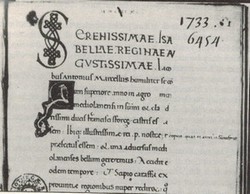
Start of the letter of Marcello
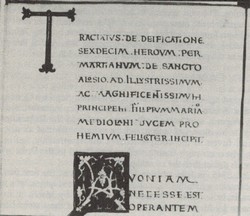
Start of the text of Martiano da Tortona
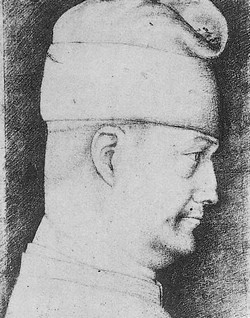
Filippo Maria Visconti, commissioner of the deck
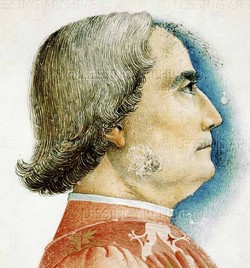
Iacopo Antonio Marcello
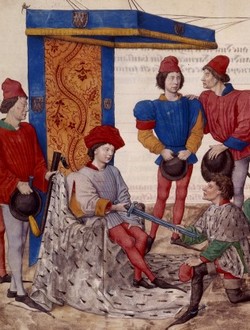
King Renée d'Anjou in his tournament book.
|
|
ABSTRACT
Some further information is provided on the earliest tarot pack described, resulting from the collaboration of Filippo Maria Visconti, Marziano da Tortona and Michelino di Besozzo1. The corresponding evidence, coming from a manuscript kept in the French National Library, is described with additional detail. Possible relations between this peculiar pack and early tarots are discussed. In particular, here the specific iconography is fully reported and commented. The situation in the mid of the 15th century is finally outlined.
PREMESSA
L'argomento di questo studio è rappresentato dai primi tarocchi dei Visconti il che equivale, almeno per quanto oggi sappiamo, ai primi di cui abbiamo una descrizione in assoluto. Dopo un breve riepilogo della relativa documentazione, si aggiungono qui alcuni complementi alla discussione presentata in un precedente studio, a cui si rimanda per le informazioni di base. Per una documentazione generale sulla materia, il riferimento obbligato è Michael Dummett, di cui abbiamo anche un'opera completa in italiano.
INFORMAZIONI DAL MANOSCRITTO
Tutta la documentazione sul tema in esame proviene dal manoscritto Lat. 8745 della Bibliothèque Nationale di Parigi (carte 1-32). Inizialmente si trova la trascrizione della lettera di Iacopo Antonio Marcello; segue il trattato di Marziano da Tortona sulla deificazione dei sedici eroi, preceduto da un interessante proemio.
La lettera di Marcello alla regina Isabella di Lorena serviva di accompagnamento per il mazzo di tarocchi e per un libro sullo stesso soggetto, già posseduto da Filippo Maria Visconti. Marcello scrive da Monselice a metà novembre del 1449 ma riferisce sui fatti dell'anno precedente, quando si trovava a capo delle truppe venete inviate in appoggio a Francesco Sforza nella guerra contro i Milanesi.
Marziano, prima del trattato, scrive un proemio di cinque pagine. La dedica è rivolta a Filippo Maria Visconti, Duca di Milano. Ciò riduce l'incertezza sulla data a pochi anni: l'insediamento a Milano di Filippo Maria, dopo la morte del fratello, avvenne nel 1412, mentre la morte di Marziano si verificò una decina d'anni dopo. Perciò il trattato si può datare con buona approssimazione verso il 1415. Si tratta così della prima testimonianza nota sui trionfi.
Il gioco è stato concepito come una sequenza di eroi, quadripartita negli ordini delle virtù (Giove, Apollo, Mercurio, Ercole), ricchezze (Giunone, Nettuno, Marte, Eolo), verginità o continenze (Pallade, Diana, Vesta, Dafne) e piaceri (Venere, Bacco, Cerere, Cupido). A questi correlati, si trovano al di sotto gli ordini di aquila, fenice, tortora e colomba, presieduti da quattro re. Per aquile e tortore le più prevalgono sulle meno mentre per fenici e colombe accade il contrario. Gli ordini non hanno potere gli uni sugli altri, ma quello degli dei prevale. Fra gli dei è più potente chi si trova prima indicato nell'elenco.
Nel "Trattato della deificazione dei sedici eroi" di Marziano i personaggi sono illustrati uno dopo l’altro, passando quindi in modo ricorrente attraverso gli ordini sopra definiti. In maniera piuttosto sistematica vengono forniti brevi cenni biografici e si rammentano le principali invenzioni utili per l'umanità (anche questo tipo di attribuzione aveva all'epoca largo seguito). Infine, Marziano dedica una frase o due a descrivere la raffigurazione tipica di ogni personaggio.
L'AMBIENTE DELLE ORIGINI
Per questo mazzo di trionfi non è immediato distinguere i contributi all'ideazione (da ripartire tra Filippo Maria e Marziano) e alla realizzazione concreta (tra Marziano e Michelino). E' soprattutto il ruolo di Marziano che può variare tra limiti estremi. Da una parte potrebbe essere minimo: l'idea è di Filippo Maria, la realizzazione artistica è di Michelino; Marziano avrebbe soltanto compilato il breve trattato di accompagnamento, di tipo letterario-mitologico. D'altra parte, il contributo di Marziano potrebbe essere stato determinante: da un vago spunto di Filippo Maria avrebbe ideato sia la strutturazione dell'insieme sia le singole figure, poi dipinte (o ridipinte meglio) da Michelino.
Visto che l'uso odierno dei tarocchi è prevalentemente divinatorio, saremmo tentati di ricercare già all'origine una traccia di questo uso. Siamo incoraggiati a immaginare qualcosa del genere dalla constatazione che Marziano fu un noto cultore di astrologia, disciplina che peraltro interessò fortemente Filippo Maria, al punto che si faceva guidare nell'attività di stato da famosi astrologi, di varia provenienza, accolti alla sua corte. Sappiamo però anche che lo stesso Duca fu un assiduo giocatore e quindi nulla vieta che i trionfi in esame fossero introdotti in ambiente puramente ludico, come li incontreremo in seguito in maniera esclusiva, per oltre tre secoli.
NUMERO DI TRIONFI E DI CARTE
Non deve sorprendere troppo che le carte trionfali siano solo sedici: che originariamente potessero essere meno delle ventidue diventate tradizionali è stato suggerito da alcuni esperti anche per spiegare la presenza di alcune carte diverse nei tarocchi Visconti-Sforza. Queste ultime sarebbero state aggiunte non per sostituire delle carte andate perdute, come si suppone di solito, ma per adeguare un precedente mazzo alla nuova tradizione. Una conferma indipendente si ricava dall'Archivio estense dove sarebbero citati antichi mazzi di trionfi di 70 carte. Esaminiamo allora la possibile composizione di questo insolito mazzo, pur riconoscendo che questa discussione è inevitabilmente di carattere speculativo.
Al di sopra delle carte numerali (non esplicitamente citate ma necessariamente presenti per rendere possibile la gerarchia discendente e ascendente indicata) ci sono le figure (di cui qui solo i re sono ricordati in maniera esplicita). Per le carte superiori, si ha un cambiamento di ruolo e qui anche di seme; però a tutti gli effetti è come se si prolungasse ognuno dei 4 semi con altre 4 carte superiori, in maniera in fondo non dissimile da come nel tradizionale mazzo di tarocchi le quattro carte figurate all’interno di ogni seme superano le dieci carte numerali.
Il meccanismo con cui questi trionfi sono stati inseriti nelle carte da gioco corrisponde a un'aggiunta di figure superiori in numero uguale per ogni seme ma probabilmente in modo da poter formare un quinto seme autonomo. Perché un sistema del genere funzioni esattamente, il numero complessivo delle carte deve essere multiplo sia di 4 che di 5, cioè di 20. Limitandosi a numeri plausibili, si può iniziare con semi di nove carte numerali e tre figure, il che ci ricorderebbe mazzi oggi comuni in Spagna; con l'aggiunta di altre tre figure superiori per seme si potrebbe ottenere un quinto seme di dodici trionfi, e un mazzo completo di 60 carte.
Ma più plausibile si presenta l'alternativa successiva, di dieci carte numerali e sei figure, per esempio personaggi sia maschili che femminili, come citati già da Giovanni da Rheinfelden e come sarebbero in parte conservati nel noto mazzo Visconti di Modrone; quattro carte superiori aggiunte per seme, come nel mazzo di Marziano, potrebbero alternativamente costituire il quinto seme dei trionfi per un totale di 80 carte, come già indicato da Michael Dummett. Di qui si sarebbe potuto ottenere in seguito il mazzo standard dei tarocchi eliminando un paio di figure e "promuovendone" sei dalle carte superiori dei quattro semi al nuovo seme dei trionfi.
Gli dei: loro scelta, tradizione mitologica
L'argomento era all'epoca di notevole attualità; sulla scia di trattatisti della tarda latinità vari autori si erano cimentati nella ridescrizione delle principali figure mitologiche. In particolare l'evemerismo - con la tradizionale trasformazione degli dei pagani in eroi "deificati" dopo la morte per le loro imprese - fu prima un'arma contro la loro adorazione, utilizzata dalla Chiesa già nei primi secoli, e servì in seguito a mantenere in vita i miti non più pericolosi collegati alle divinità antiche.
I sedici personaggi selezionati per la deificazione rappresentano una scelta abbastanza ragionevole fra le molte possibilità offerte dalla mitologia greco-romana. Si può notare che sono all'incirca metà maschi e metà femmine, tanto che ci sembra quasi una svista la presenza di nove dei e sette dee.
Un po' sorprendenti risultano le assenze di dei come Saturno, Plutone e Vulcano. Viceversa, alcune delle presenze, come quelle di Eolo o di Cupido, sembrano corrispondere a una sopravvalutazione del loro ruolo nella mitologia classica; ma è soprattutto la presenza di Dafne a apparire estranea alle divinità dell'Olimpo, benché la sua metamorfosi avesse già ispirato tanti artisti.
Corrispondenza con i trionfi comuni
Non è facile capire se si abbia qui un prototipo inventato come variante delle comuni carte da gioco, e quindi preliminare alla successiva affermazione dei tarocchi, oppure una variante immaginata a partire da un mazzo di tarocchi già esistente. Solo nel primo caso si avrebbe una testimonianza diretta sulla nascita del nuovo gioco. Tuttavia una distinzione del genere non è in fondo determinante. Anche se si trattò di una variante di trionfi già esistenti, questi dovevano comunque trovarsi in uno stadio primitivo corrispondente tutt'al più solo in parte ai tarocchi tradizionali.
Esaminando i comuni tarocchi di Marsiglia si nota che i trionfi sono in parte personaggi a tutto campo, in parte scene in cui i personaggi sono più di uno e in secondo piano. Si può tuttavia supporre che all'origine esistessero minori differenze formali fra le figure delle carte superiori dei quattro semi e quelle del seme addizionale dei trionfi: prevalentemente tipici personaggi mitologici o di corte.
Come corrispondenza di figure, alcuni personaggi possono considerarsi strettamente analoghi, come Imperatore-Giove, Imperatrice-Giunone, Amore-Cupido, Papessa-Vesta, Carro-Marte; altri sono ottenibili con semplici trasformazioni: Forza-Ercole, Giustizia-Demetra, Matto-Mercurio. Continuando per questa via si incontrano tuttavia difficoltà considerevoli nell'appaiare tutte le figure di Marziano a sedici opportunamente scelte fra i trionfi canonici. Sorprende di nuovo l'assenza fra i sedici personaggi di Saturno, unico assente dei sette pianeti, che invece potrebbe trovare facilmente una controfigura nei trionfi tradizionali.
D'altra parte, da un confronto del genere restano fuori i trionfi dal significato marcatamente negativo, come del resto appare logico trattandosi qui di una deificazione di eroi: mancano quindi possibili ruoli per carte come Impiccato, Morte, Diavolo, Torre, o loro corrispondenti.
Iconografia dei trionfi
L'iconografia di queste immagini si presenta, nel complesso, meritevole di attenzione da parte degli esperti. Vista la sua relativa originalità, mi è sembrato utile ricapitolarne i principali lineamenti in forma di tabella.
I. Giove. Seduto in trono è provvisto di quattro insegne celesti: a destra in alto lo splendore della giusta ragione; a sinistra in alto la luce con cui fondò le leggi; in basso a destra la stella lucente simile a Marte che brilla nei salvatori dello stato; in basso a sinistra il fulmine.
II. Giunone. L'aspetto la indica sposa di Giove; col capo velato all'uso delle matrone, l'ordine della corona indica il numero dei regni. E' ornata riccamente; le sue belle vesti colorate sono però evanescenti. Il carro e le armi, a lei assegnati da Virgilio, sembrano qui da tralasciare.
III. Pallade. Colla destra tiene un pacifico olivo; indossa un amitto multiplo e una veste variegata (a indicare le modifiche col tempo dei pareri dei saggi). Tiene un leggero scudo reso orribile dalla Gorgone.
IV. Venere. Con aspetto piuttosto lascivo, chioma sparsa, petto e braccia scoperti, ginocchi nudi, per indurre più facilmente all'amore; con un amitto sciolto di pelle di lince; con l'arco pronto e la faretra indosso per cacciare e ferire gli animi degli uomini che vagano nelle tenebre.
V. Apollo. Ha aspetto conforme alla vita militare; il capo chiomato è adorno di alloro per diritto guerriero e poetico; porta arco e frecce nel cui uso eccelse.
VI. Nettuno. Con aspetto regale di vecchio stampo siede su un carro d'oro trainato da due delfini. Ha un tridente per scettro a indicare le tre proprietà dell'acqua.
VII. Diana. Vestita di un amitto bianco, vaga con arco e frecce su una biga d'oro, trainata da bianchi cervi con corna dorate brillanti. Si raffigura con aspetto trino.
VIII. Bacco. Con volto sempre giovanile e le tempie ornate con le sue viti. Secondo il suo nome, porta un bastone per il sostegno degli ubriachi. Tirano il carro due tigri.
IX. Mercurio. Come gli Arcadi ha il capo coperto da un galero; col caduceo separa serpenti in lotta; calza i talari.
X. Marte. Col carro decorato da mille insegne tolte ai nemici... Cavalca con la spada sguainata cosparsa di sangue a indicare la via.
XI. Vesta. Dall'aspetto castigato alla maniera delle monache sta presso l'altare davanti agli immortali e prega gli dei.
XII. Cerere. Procede con abito regale e mèssi ai lati; tiene in mano una fiaccola ardente.
XIII. Ercole. Con il terribile aspetto, la fronte incoronata di alloro, trascurando vesti leggiadre, con le spoglie dell'enorme leone Nemeo, insigne monumento della forza. Ai suoi piedi giace colpito dalle frecce il mostro antropomorfo delle Strofadi.
XIV. Eolo. Seduto in abito regale tra gli scogli delle sue isole ricavando fiamme con lo scettro.
XV. Dafne. In abito virgineo abbracciata al suo Alloro.
XVI. Cupido. In volo per marcare l'instabilità degli amanti è cinto di cuori umani. Vaga nudo per cielo e terra con l'arco pronto a scoccare.
Nel dettaglio non vengono più seguite le tradizioni più antiche degli Aratea nè quelle di origine araba, diretta o come tramite di influenze babilonesi. Sembrerebbe allora naturale attendersi una marcata fedeltà al canone di Alberico che all'epoca si andava affermando anche grazie alla fortuna del "De genealogiis deorum gentilium".
Invece la ricostruzione delle immagini di Marziano dalle opere letterarie si presenta prevalentemente autonoma. Degni di nota Giove con i quattro segni celesti ai margini, Venere cacciatrice vestita di pelle di lince, Marte a cavallo con la spada insanguinata (anche se il suo famoso carro è citato in precedenza), Vesta in abito monacale ormai completamente "cristianizzata", Cerere con in mano la fiaccola per purificare i campi.
A una svista di Marziano è forse da attribuire la raffigurazione di Dafne in abito virgineo abbracciata al suo alloro; di solito è Apollo che abbraccia Dafne già in parte trasformata in alloro.
Anche i carri su cui alcuni dei sono raffigurati sono alquanto particolari: spesso d'oro, sono trainati da coppie di delfini, cervi e tigri rispettivamente per Nettuno, Diana e Bacco; siamo già sulla via che porterà alle divinità dello Zucchi, trionfanti sui propri carri.
LA SITUAZIONE IN LORENA E LOMBARDIA A META' QUATTROCENTO
La parte della testimonianza di Iacopo Antonio Marcello relativa al proprio tempo e alla propria iniziativa presenta il seguente problema: come potevano queste carte essere utilizzate alla corte di Lorena se a noi risulterebbe che i tarocchi giunsero in Francia soltanto in seguito, probabilmente nel secolo successivo? E' una domanda che ammette più di una risposta, compresa quella che l'assenza di testimonianze non equivale all'assenza del gioco.
Il più plausibile motivo di collegamento è dato proprio dalla figura della regina Isabella. La Lorena non era un regno, ma la duchessa di Lorena si trovava ad essere regina... di Sicilia. La stessa Isabella aveva eroicamente attraversato l'Italia per far valere contro la casa di Aragona i diritti ereditari del marito Renato d'Angiò, tenuto prigioniero a Digione. Così, in via di principio, la regina avrebbe potuto conoscere in Italia il gioco dei trionfi; d'altra parte il re Renato era notoriamente inserito in un ambiente artistico e letterario di prestigio. In seguito, la regina avrebbe potuto distrarsi con i trionfi durante i lunghi soggiorni nel maniero di Launay, presso Saumur, dove trascorse la maggior parte di quegli anni, fino alla morte (1453).
Per quanto riguarda la storia dei tarocchi in Lombardia, la situazione nel 1448-49, al tempo della lettera di Marcello e dei fatti che riferisce, appare ben diversa rispetto al mazzo di Marziano. Siamo ancora in tempi precoci per quanto riguarda il complesso delle testimonianze conservate sui tarocchi. Ma la situazione è evidentemente cambiata: mazzi di trionfi sono in uso nel campo di Francesco Sforza e servono a passare il tempo nell'attesa delle operazioni belliche. Inoltre, esistevano già artigiani specializzati nella produzione di mazzi di tarocchi - è proprio a uno di questi che Marcello cerca di rivolgersi per un esemplare di qualità superiore. Chiaramente, verso la metà del Quattrocento i tarocchi non sono più, ammesso che lo siano stati in origine, oggetti rari e preziosi. Ormai fra i mazzi in circolazione in Lombardia diventa difficile trovare un esemplare fuori del comune, adatto per la regina Isabella.
CONCLUSIONI
Le informazioni ricavabili da questa testimonianza sull'origine dei tarocchi hanno un'importanza considerevole. A differenza di altri casi, qui siamo davvero vicini all'origine dei tarocchi, tanto vicini che oggi qualsiasi indicazione di epoca precedente non può essere considerata che a livello di ipotesi.
L'iconografia dei primi tarocchi Visconti è particolare e, insieme alla selezione dei personaggi "deificati" in questo mazzo straordinario, meriterebbe un'analisi approfondita da parte degli esperti.
Nelle discussioni in corso fra gli storici delle carte da gioco, questa testimonianza si pone a supporto di un ampliamento del mazzo comune per dar luogo ai tarocchi: i trionfi poterono nascere come estensione verso l'alto di una gerarchia già presente all'interno dei quattro semi tradizionali e che avrebbe finito con il produrre una gerarchia indipendente, valida solo all'interno delle figure superiori aggiunte. Probabilmente fu necessario un certo tempo perché le figure "trionfali" si separassero nettamente, come immagini e come funzioni, dalle figure superiori dei quattro semi.
Side bar pictures and text added by Lothar Teikemeier
|
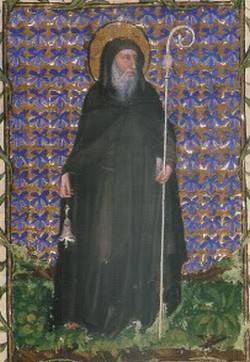
Illustrations in a prayer book
by Michelino da Besozzo
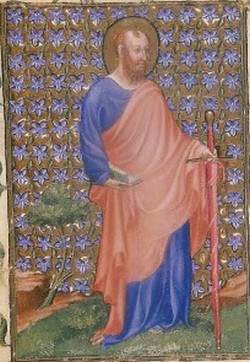
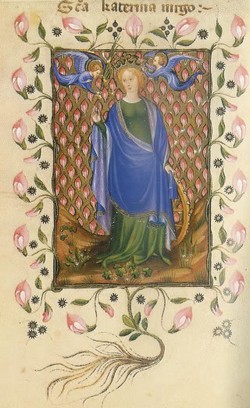
|
|



